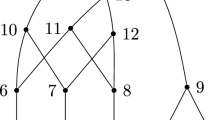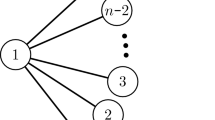Abstract
Tolerance graphs model interval relations in such a way that intervals can tolerate a certain degree of overlap without being in conflict. This class of graphs has attracted many research efforts, mainly due to its interesting structure and its numerous applications, especially in DNA sequence analysis and resource allocation, among others. In one of the most natural generalizations of tolerance graphs, namely multitolerance graphs, two tolerances are allowed for each interval—one from the left and one from the right side of the interval. Then, in its interior part, every interval tolerates the intersection with others by an amount that is a convex combination of its two border-tolerances. In the comparison of DNA sequences between different organisms, the natural interpretation of this model lies on the fact that, in some applications, we may want to treat several parts of the genomic sequences differently. That is, we may want to be more tolerant at some parts of the sequences than at others. These two tolerances for every interval—together with their convex hull—define an infinite number of the so called tolerance-intervals, which make the multitolerance model inconvenient to cope with. In this article we introduce the first non-trivial intersection model for multitolerance graphs, given by objects in the 3-dimensional space called trapezoepipeds. Apart from being important on its own, this new intersection model proves to be a powerful tool for designing efficient algorithms. Given a multitolerance graph with n vertices and m edges along with a multitolerance representation, we present algorithms that compute a minimum coloring and a maximum clique in optimal O(nlogn) time, and a maximum weight independent set in O(m+nlogn) time. Moreover, our results imply an optimal O(nlogn) time algorithm for the maximum weight independent set problem on tolerance graphs, thus closing the complexity gap for this problem. Additionally, by exploiting more the new 3D-intersection model, we completely classify multitolerance graphs in the hierarchy of perfect graphs. The resulting hierarchy of classes of perfect graphs is complete, i.e. all inclusions are strict.









Similar content being viewed by others
Notes
Note here that, in a parallelepiped representation of a tolerance graph, the height of the line P v that corresponds to an unbounded vertex v, equals the slope ϕ v of the line \(\overline{P}_{v}\), which is the projection of P v to the plane z=0; for details, see [21]. On the other hand, in the trapezoepiped representation R′′ (cf. line 1 of Algorithm 1), the height of the line T v that corresponds to the unbounded vertex v∈V U equals Δ−cot(ϕ v ), where ϕ v is the slope of the line \(\overline{T}_{v}\), which is the projection of T v to the plane z=0. Note that for every two unbounded vertices u,v∈V U of the multitolerance graph G, Δ−cot(ϕ v )>Δ−cot(ϕ u ) if and only if ϕ v >ϕ u . Therefore, R′′ can be considered as a special case of a parallelogram representation by changing the height of every line T v , where v∈V U , from Δ−cot(ϕ v ) to ϕ v , since this change of the heights of the lines does not change the relative position of any two lines in R′′.
There exists a lower time bound of Ω(nlogn) for computing the length of a longest increasing subsequence in a permutation [6], and thus the same lower bound holds for computing a maximum clique and a maximum independent set in a permutation graph G. Furthermore, since permutation graphs are perfect graphs [7], the chromatic number χ(G) of a permutation graph G equals the clique number ω(G) of G. Thus, Ω(nlogn) is a lower time bound for computing the chromatic number of a permutation graph. Finally, since the class of permutation graphs is a subclass of trapezoid graphs [11], the same lower bounds apply to trapezoid graphs.
It was claimed in [23] (in Theorem 3.1(b)) that tolerance graphs are strictly included in multitolerance graphs; however, in the proof of that theorem only inclusion has been shown, and not strict inclusion. We prove strict inclusion in Theorem 7. Moreover, it has been correctly shown in [23] that a multitolerance graph does not contain any chordless cycle C n , where n≥5. We prove in Theorem 7 that actually the same holds also for the complements \(\overline{C}_{n}\) of C n , where n≥5, and thus every multitolerance graph is weakly chordal.
References
Altschul, S.F., Gish, W., Miller, W., Myers, E.W., Lipman, D.J.: Basic local alignment search tool. J. Mol. Biol. 215(3), 403–410 (1990)
Bogart, K.P., Fishburn, P.C., Isaak, G., Langley, L.: Proper and unit tolerance graphs. Discrete Appl. Math. 60(1–3), 99–117 (1995)
Bogart, K.P., Isaak, G.: Proper and unit bitolerance orders and graphs. Discrete Math. 181(1–3), 37–51 (1998)
Busch, A.H.: A characterization of triangle-free tolerance graphs. Discrete Appl. Math. 154(3), 471–477 (2006)
Felsner, S.: Tolerance graphs and orders. J. Graph Theory 28(3), 129–140 (1998)
Felsner, S., Müller, R., Wernisch, L.: Trapezoid graphs and generalizations, geometry and algorithms. Discrete Appl. Math. 74, 13–32 (1997)
Golumbic, M.C.: Algorithmic Graph Theory and Perfect Graphs. Annals of Discrete Mathematics, vol. 57. North-Holland, Amsterdam (2004)
Golumbic, M.C., Monma, C.L.: A generalization of interval graphs with tolerances. In: Proceedings of the 13th Southeastern Conference on Combinatorics, Graph Theory and Computing. Congressus Numerantium, vol. 35, pp. 321–331 (1982)
Golumbic, M.C., Monma, C.L., Trotter, W.T.: Tolerance graphs. Discrete Appl. Math. 9(2), 157–170 (1984)
Golumbic, M.C., Siani, A.: Coloring algorithms for tolerance graphs: reasoning and scheduling with interval constraints. In: Proceedings of the Joint International Conferences on Artificial Intelligence, Automated Reasoning, and Symbolic Computation (AISC/Calculemus), pp. 196–207 (2002)
Golumbic, M.C., Trenk, A.N.: Tolerance Graphs. Cambridge Studies in Advanced Mathematics (2004)
Goodrich, M.T., Tamassia, R.: Algorithm Design: Foundations, Analysis, and Internet Examples. Wiley, New York (2002)
Grötschel, M., Lovász, L., Schrijver, A.: Polynomial algorithms for perfect graphs. Ann. Discrete Math. 21, 325–356 (1984)
Hershberger, J.: Finding the upper envelope of n line segments in O(nlogn) time. Inf. Process. Lett. 33(4), 169–174 (1989)
Isaak, G., Nyman, K.L., Trenk, A.N.: A hierarchy of classes of bounded bitolerance orders. Ars Comb. 69 (2003)
Kaufmann, M., Kratochvil, J., Lehmann, K.A., Subramanian, A.R.: Max-tolerance graphs as intersection graphs: cliques, cycles, and recognition. In: Proceedings of the 17th Annual ACM-SIAM Symposium on Discrete Algorithms (SODA), pp. 832–841 (2006)
Lehmann, K.A., Kaufmann, M., Steigele, S., Nieselt, K.: On the maximal cliques in c-max-tolerance graphs and their application in clustering molecular sequences. Algorithms Mol. Biol. 1 (2006)
Ma, T.-H., Spinrad, J.P.: On the 2-chain subgraph cover and related problems. J. Algorithms 17(2), 251–268 (1994)
McKee, T.A., McMorris, F.R.: Topics in Intersection Graph Theory. SIAM Monographs on Discrete Mathematics and Applications. SIAM, Philadelphia (1999)
Mertzios, G.B., Corneil, D.G.: Vertex splitting and the recognition of trapezoid graphs. Discrete Appl. Math. 159(11), 1131–1147 (2011)
Mertzios, G.B., Sau, I., Zaks, S.: A new intersection model and improved algorithms for tolerance graphs. SIAM J. Discrete Math. 23(4), 1800–1813 (2009)
Mertzios, G.B., Sau, I., Zaks, S.: The recognition of tolerance and bounded tolerance graphs. SIAM J. Comput. 40(5), 1234–1257 (2011)
Parra, A.: Triangulating multitolerance graphs. Discrete Appl. Math. 84(1–3), 183–197 (1998)
Spinrad, J.P., Sritharan, R.: Algorithms for weakly triangulated graphs. Discrete Appl. Math. 59, 181–191 (1995)
Acknowledgements
The author would like to thank Sagi Snir from the University of Haifa, Israel, for indicating the application of multitolerance graphs in the comparison of DNA sequences.
Author information
Authors and Affiliations
Corresponding author
Additional information
A preliminary conference version of this work appeared in Proceedings of the ACM-SIAM Symposium on Discrete Algorithms (SODA), San Francisco, California USA, January 2011, pp. 1306–1317.
Rights and permissions
About this article
Cite this article
Mertzios, G.B. An Intersection Model for Multitolerance Graphs: Efficient Algorithms and Hierarchy. Algorithmica 69, 540–581 (2014). https://doi.org/10.1007/s00453-012-9743-2
Received:
Accepted:
Published:
Issue Date:
DOI: https://doi.org/10.1007/s00453-012-9743-2




